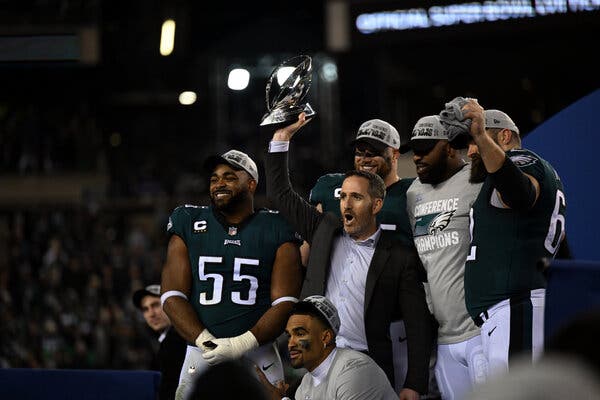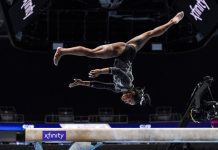The Philadelphia Eagles’ general manager, Howie Roseman, hustled like a pool shark. The Detroit Lions’ coach, Dan Campbell, displayed his rugged individualism. And the Green Bay Packers, playing the role of a merry divorcé post-Aaron Rodgers trade, dallied with new playmakers.
This year’s N.F.L. draft provided an opportunity for some of the league’s most fascinating decision makers and franchises to truly express themselves. Here are the teams that made clever moves, and a few players who came up a bit short.
Eagles, Reloaded
The Eagles should not be able to do the things they do.
A team that won 14 games and reached the Super Bowl last season should not have a top 10 pick in the next draft. That team should not have the opportunity to draft both Jalen Carter, possibly the most talented player in his class, and his Georgia defensive linemate Nolan Smith, who produced astounding workout results at the scouting combine.
That team should not have later been able to add four more potential starters: offensive lineman Tyler Steen, a steady performer for Vanderbilt and Alabama; Illinois safety Sydney Brown, who intercepted six passes for one of the nation’s best defenses in 2022; cornerback Kelee Ringo, yet another member of Georgia’s back-to-back national championship teams; and, through a trade, the veteran running back D’Andre Swift (Georgia, again), who scored eight touchdowns last year for the Detroit Lions.
Finally, a team nursing a Super Bowl hangover should not have been able to lock its star quarterback, Jalen Hurts, into a reported five-year, $255 million contract extension before the draft. Such a team would normally be salary-cap strapped, and such contracts are supposed to be preceded by months of melodrama.
The Eagles accomplished all of those things thanks to the Wolf of Broad Street wizardry of Roseman. Among other feats, Roseman acquired the ninth overall pick that the Eagles used on Carter (whose stock had slipped because of his involvement in a fatal car crash) as part of a complex web of trades dating back to 2021; stuffed the bulk of Hurts’s compensation into future balloon payments so the Eagles could retain other core veterans; and engineered the trades that landed the team the Ringo pick and Swift as a Saturday aperitif.
Other teams may have done more than the Eagles to improve their rosters in this weekend’s N.F.L. draft. No team, however, did more to improve its chances of winning next year’s Super Bowl. Of course, it helps that the Eagles, thanks to their draft-weekend brilliance in past years, did not have many improvements left to make.
Revenge on the Nerds
One of the fundamental tenets of football analytics is that running backs and linebackers are bad investments in the first round of the draft: There’s a surplus of talent at those positions, running back careers are short and linebackers have a limited role in the pass-happy modern N.F.L.
The Lions, coached by Campbell, the archetypal tough guy, gave the analytics community an atomic wedgie in the first round by drafting both Alabama running back Jahmyr Gibbs and Iowa linebacker Jack Campbell (no relation to Dan). Gibbs was not even the first running back selected — the Atlanta Falcons chose Bijan Robinson of Texas eighth overall — and Jack Campbell is the type of 249-pound run-stopping sledgehammer that has been on the verge of extinction for years.
The selection of Iowa tight end Sam LaPorta early in the second round — tight end is considered another position of low marginal value — further fueled the analytics nerds’ rage.
Tempers cooled when the Lions selected Alabama defensive back Brian Branch, a first-round talent according to many experts, with the 45th overall pick. The team then selected Tennessee quarterback Hendon Hooker with the 68th pick. Hooker might have been a first-round selection if he were not already older than many N.F.L. starters (he turned 25 in January) and if he had not torn an anterior cruciate ligament in November.
Suddenly, the Lions’ efforts looked less like a tipsy father-in-law’s fantasy draft and more like a master class in resource management.
A second dictate of football analytics stresses that scouting is so imprecise that acquiring an abundance of extra draft picks is a far better tactic than trading up to target one coveted prospect. The Lions received a bundle of picks from the Los Angeles Rams when they traded away quarterback Matthew Stafford in 2021, and they acquired an extra second-round pick from the Arizona Cardinals by trading down before selecting Gibbs. As a result, they came away from Friday night with several potential starters and a possible franchise quarterback. They just did so in an unusual order.
Requiem for the Featherweights
The 2023 draft class was glutted with shifty, speedy receivers who wouldn’t weigh 180 pounds even after a never-ending pasta bowl. It turned out that N.F.L. teams were lukewarm about such prospects.
Receiver Jordan Addison of Southern California, who weighed 173 pounds at the scouting combine, did go in the first round, joining the Minnesota Vikings with the 23rd overall pick. However, other receivers who had first-round reputations but weighed less than 180 pounds were forced to wait until the third round: Jalin Hyatt of Tennessee (177 pounds, Giants, 73rd overall), Josh Downs of North Carolina (171 pounds, Indianapolis Colts, 79th overall) and Nathaniel Dell of Houston (just 165 pounds, Houston Texans, 69th overall).
Bigger but less heralded receivers like Jonathan Mingo of Mississippi (220 pounds, Carolina Panthers, 39th overall) and Rashee Rice of Southern Methodist (204 pounds, Kansas City Chiefs, 55th overall), however, heard their names called earlier than expected.
Boston College receiver Zay Flowers bulked up to 182 pounds and joined the Baltimore Ravens with the 22nd overall pick. When it comes to reaching N.F.L. scouting benchmarks, an extra helping of smothered hash browns can go a long way.
Even so, N.F.L. teams are more willing to invest in sub-180 pound receivers now than they once were. Three such prospects were selected in the first two rounds of the 2022 draft, but their fortunes illustrate the upside and downside of drafting receivers the size of high school soccer players. Jameson Williams of the Lions missed most of the season with a collegiate injury and is now facing a gambling suspension. Jahan Dotson of the Washington Commanders flashed brilliance but missed five midseason games with a hamstring injury. Wan’Dale Robinson of the Giants began to establish himself as an elusive catch-and-run threat before suffering an A.C.L. injury.
If Hyatt and Robinson can stay healthy, not only will the Giants have a dynamic, unpredictable offense, but they will also save a little on grocery bills.
Petty Packers
Some teams draft the best available athletes. Others draft for need. The Packers may be the first N.F.L. team ever to draft for spite. Having finally traded Rodgers to the Jets at the start of the week, the Packers assembled a draft class that appeared custom tailored to make Rodgers jealous.
The Packers added three pass catchers on Friday evening: Oregon State tight end Luke Musgrave (42nd overall), Michigan State receiver Jayden Reed (50th) and South Dakota State tight end Tucker Kraft (78th). The Packers chose Musgrave, a 6-foot-6 target of the type Rodgers prefers, one spot ahead of the Jets, using one of the picks they acquired in the Rodgers trade.
The Packers were depleted at tight end, and they needed to rebuild their offense for their new starting quarterback, Jordan Love, so of course they did not really select a trio of versatile playmakers as the football equivalent of wearing a white dress to an ex-spouse’s wedding.
Still, the Jets had a rather quiet weekend — their picks included defensive end Will McDonald IV, center Joe Tippmann and offensive tackle Carter Warren, who are fine additions but not headline-grabbers — while the Packers cheerfully embraced a future without Rodgers.
Living well, after all, is the best revenge.
Hits: 0











